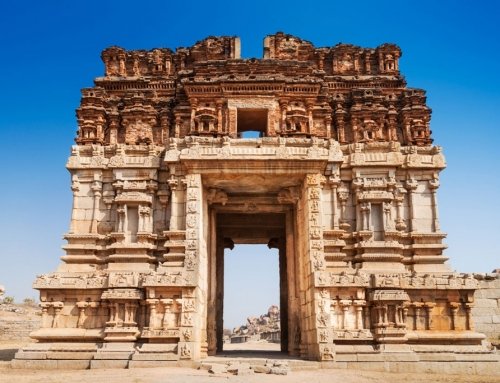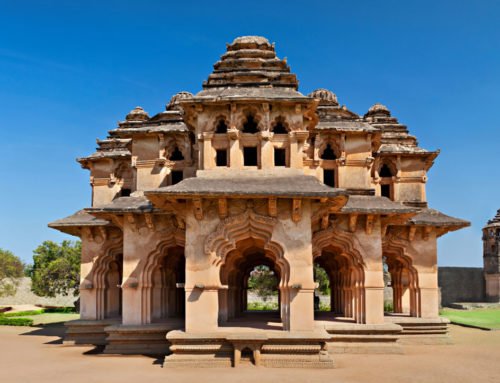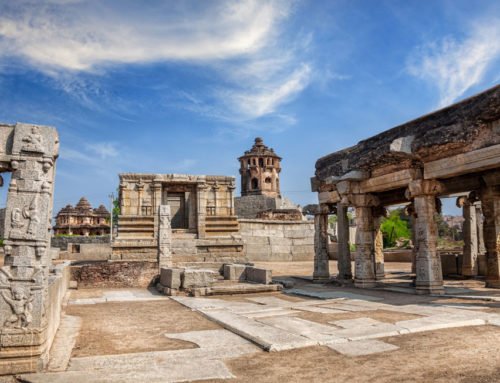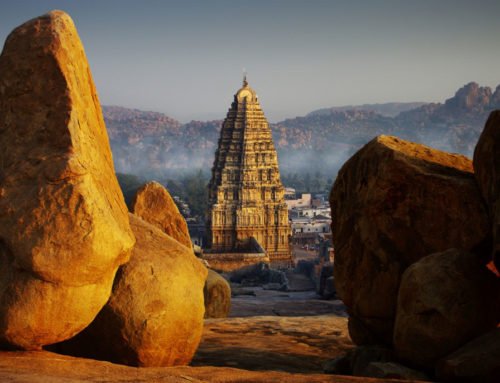Overview
- Features: Ruins of temples, compounds, stables and pleasure baths surrounded by a stunning boulder-strewn landscape
- Opening Times: Dawn to dusk, daily
- Best Time to Visit: Late October to early March
- Duration: Half a day
- Travelled By: Foot
- Cost: Free
- Address: Hampi, Karnataka, India
- Type: Historic site
Author Reviews[display_rating_item_results rating_form_id=”2″ rating_entry_ids=”1″ show_category_filter=”false” show_options=”true” result_type=”star_rating” preserve_max_rating=”true” show_title=”false” show_count=”false” ]
Total Rating: [display_rating_result rating_form_id=”2″ show_count=”false” show_rich_snippets=true] [accordions load=”1″] [accordion title=”User Reviews” last] [display_rating_item_results rating_form_id=”5″ show_options=”true” result_type=”star_rating” preserve_max_rating=”true” show_title=”false” show_count=”true” show_rich_snippets=true] [/accordion] [accordion title=”Add Review”][display_rating_form show_email_input=”true” show_comment_textarea=”true” show_name_input=”true” rating_form_id=”5″] [/accordion] [/accordions]
Summary
It’s difficult to say what’s more charming in Hampi – whether it’s the amazing architecture or the bizarre looking landscape. Heaps of giant Hampi boulders perch precariously over miles of undulated terrain, their rusty hues off set by jade-green palm groves, banana plantations and paddy fields. A World Heritage Site, Hampi is a place where you can lose yourself among the ruins.
Hampi Boulders
It’s difficult to say what’s more charming in Hampi – whether it’s the amazing architecture or the bizarre looking landscape. While the architecture is easily understood, any visitor to Hampi wonders how such a landscape was created in the first place.
Unreal and bewitching, the forlorn ruins of Hampi dot an unearthly landscape that will leave you spellbound the moment you cast your eyes on it. Heaps of giant Hampi boulders perch precariously over miles of undulated terrain, their rusty hues off set by jade-green palm groves, banana plantations and paddy fields. The azure sky painted with fluffy white cirrus only adds to the magical atmosphere. A World Heritage Site, Hampi is a place where you can lose yourself among wistful ruins, or simply be mesmerised by the vagaries of nature, wondering how millions of years of volcanic activity and erosion could have resulted in a landscape so captivating.
Millions of years ago no boulders covered Hampi’s landscape as they do these days. The wind and rain had continuously swept away the soft soil exposing the hard rocky outcrops underneath. In fact, what you see today in Hampi is one of the oldest surfaces on earth.
[singlepic id=1687 w=720 h=560 float=center]
Due to the elements and the fault lines below these rocky surfaces, cracks formed and the never-ending boulder formations began. Natural erosion polished the cyclopean boulders into bizarre shapes. In the same manner as pebbles are polished by a flowing river, so was Hampi’s boulders smoothed by the blowing wind. This continued for thousands of years resulting in a mysterious looking landscape, as if god had emptied a bag of boulders over Hampi.
On the topic of god, there is a dearth of mythology related to god in Hampi. It is believed that Hampi was the setting for parts of the Hindu epic poem, the Ramayana. Hampi was a monkey kingdom where two monkey brothers, Vali and Sugreeva, were at war over the throne of the kingdom. During the battles, they used the Hampi boulders to throw at each other.
[singlepic id=1690 w=720 h=560 float=center]
Leaving the gods behind, let’s see what men did with the Hampi boulders. Believe it or not, they made an imperial city out of the boulders. The founders of the Vijayanagar Empire (of which Hampi was the capital) chose this area for several reasons. Firstly, their guru advised them of the spiritual powers of this place and requested they make it their capital. Secondly, from a strategic standpoint, this area had many advantages. The chain of boulder hills made a natural fortress around a vast, fertile area. At one end was the long and torrential Tungabhadra River which made an impregnable border for the empire it became a few centuries later.
To see this for yourself, just climb to the top of Matunga Hill, the tallest point in Hampi. From there, you will get a panoramic view of the chain of hills that surrounds the area and marks the horizon.
[singlepic id=1675 w=720 h=560 float=center]
The Vijayanagara kings could build such beautiful and extravagant structures in Hampi due to the availability of granite blocks in various sizes. The result was an unending row of civil, military and religious structures that were built by generations of Vijayanagara kings over many centuries. They followed certain norms when working with the granite boulders. For example, boulders were rarely quarried from certain areas of Hampi due to its religious sanctity. In other words, many hills were considered sacred and were therefore left intact; instead temples and shrines were built on it.
[singlepic id=1685 w=720 h=560 float=center]
An interesting part of Vijayanagara architecture was the way they sliced the Hampi boulders. All they needed were some rudimentary tools to make holes in the boulders, a few wooden pegs and a bit of water to split a boulder as big as an elephant. Some of these holes can still be seen today in some of the boulders lying around Hampi.
[singlepic id=1683 w=720 h=560 float=center]
The first thing they did was to select a boulder and make a cutting plan. The use of the boulder decided how this was to be done. For example, for the massive monolithic pillars, the artisans required granite blocks of comparable size to be used as the basic material for the carvings. For this type of architecture, they required several identical blocks of granite in large quantities.
Once the size of block was decided, the quarrying process was initiated from the nearest possible location. A series of holes, about 3 or 4 inches deep, were dug along the line of the required cut. The holes were typically 4 to 6 inches apart in a straight line.
Once this was done, the next process was to drive wooden pegs into these holes in such a way that it didn’t split the boulder. These pegs were then made to expand by soaking them in water. The enormous force these pegs would apply along the line would make the boulder split neatly into two pieces. The process was repeated until the required size of granite block was achieved. In all probability, they would have used elephants to move the quarried granite blocks to the final place of work.
[singlepic id=1680 w=720 h=560 float=center]
In addition to using the Hampi boulders as building material, the boulders were also used in situ at many places as religious artefacts. For example, the two giant images of Ganpati in Kadlekalu Ganesha Temple and the Sasivekalu Ganesha Temple were originally giant boulders. Later these idols were carved out of the boulders and the temples were built around it. The same case applies to Kodandarama Temple on the river’s edge and the giant monolithic Nandi at the end of the Hampi Bazaar.
[singlepic id=1692 w=720 h=560 float=center]
Apart from these massive works, you can also see hundreds of religious images carved into the boulder surfaces as you make your way through the Hampi ruins.
The Vijayanagara Empire crumbled after a few hundred years of existence; however, the Hampi boulders have survived along with the signature left behind by the Vijayanagara art on the surface of these boulders.
[singlepic id=1689 w=720 h=560 float=center]
Recently, the Hampi boulders have another set of fanfare following, that is, bouldering enthusiasts from all over the world. Bouldering is an outdoor sport that involves climbing over large boulders simply with the use of bare hands. Boulders are selected for their level of difficulty to climb. Higher grades mean a higher level of difficulty.
So what makes Hampi so special among the bouldering fraternity? The answer is the endless variety of boulders Hampi has to offer. Whether one is a novice boulderer or one of international reputation, Hampi has many grades for them to master.
Come the cooler and rainless months of the year and hundreds of bouldering fans descend on Hampi from all around the world. And the Hampi boulders absorb them with remarkable ease.
Needless to say, bouldering is one of the least damaging sports from an environmental perspective. If leaving footprints is considered alright, leaving behind a few chalk powdered finger marks on the boulders for the next monsoon rain to wash off would surely be harmless enough.








Your post on the Hampi boulders is amazing. After reading all the info and looking through the lovely photos I want to go there now.
Thanks Mittie. Hampi is really a cool place to visit. Hope you can go sometime soon. 🙂